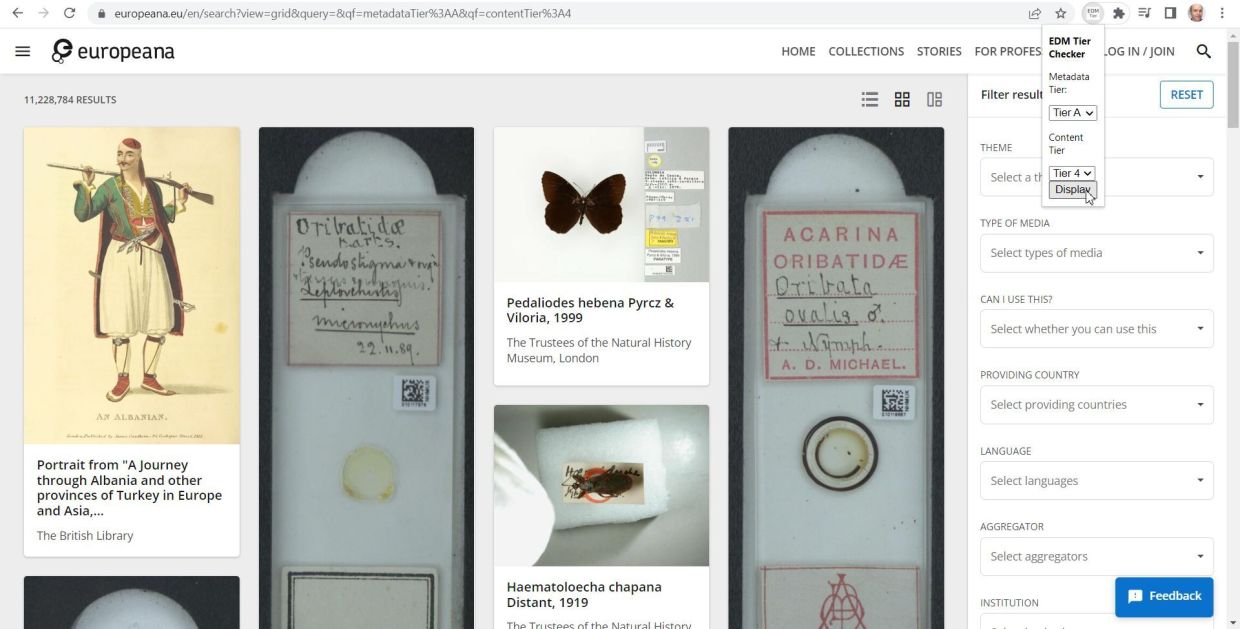The Data Statistics Dashboard and the EDM Tier Checker are products developed using Europeana’s APIs. The former was developed by the Europeana Foundation, the latter is a product developed by partners. This shows how others can contribute to the suite of products that support data quality, addressing use cases not covered by Europeana Foundation developed products and sharing them with the community.
The Metis Sandbox
The most powerful product that the Europeana Initiative has developed to support the publication of high-quality data is the Metis Sandbox. Unlike the tools above, the Metis Sandbox allows data providers to evaluate the quality of data before it is published on the Europeana website, as it allows them to simulate the enrichment and publication procedure that Europeana will perform on their data. This means they can get feedback, see what their data would look like on the actual Europeana website and get insights into the quality of the data. The application helps aggregators and cultural heritage institutions get a sense of how well-prepared their data is for ingestion by Europeana.
The development of the Metis Sandbox began under the Europeana Common Culture Generic Services project, and aimed to shorten the feedback loop between data partners and the Europeana Data Publishing Services (DPS) team. Using the Metis Sandbox, a data partner can work on the data without involving the Europeana DPS team. Data issues can be fixed at an earlier stage and feedback from cultural heritage institutions can be sought before the data is submitted to Europeana. This reduces a lot of the back and forth communication between institutions, an aggregator and the DPS team to make data ready for publication in Europeana.
Powerful features
The Metis Sandbox is more than just a preview of the data in the Europeana website; it also offers features to analyse the data in a granular way and report the findings.
For example, through the ‘tier report’ feature, a data provider can find formation on the quality of a specific piece of metadata. The report specifies, for example, the resolution of the image used as a representation of the cultural heritage object and explains why it complies with a particular quality tier. It specifies which metadata fields are expected to have a language attribute, and which fields have the language attribute and which do not. It also provides a full analysis of the quality of the contextual information, and where potentially more contextual information can be provided. This can help to identify areas for improvements, or at least clarifies what can be achieved with the data as it stands.
The most recent feature introduced in the Metis Sandbox is the ability to analyse data quality criteria that are not part of the content or metadata tiers calculation. The titles and descriptions of cultural heritage objects are the first focus for this feature. Using this feature can help answer questions like ‘is this title or description unique?’ or ‘can we expect this title or description to be meaningful based on its length and the type of characters used?’. This way, someone using the Metis Sandbox will be informed of potential problems with titles and descriptions used in the data. Providing at least one of them is mandatory for a metadata record published in Europeana, and so it is expected that the reports about the quality of titles and descriptions will help to improve them over time.
Find out more
This news post kicks off our January Europeana Pro News focus on the Metis Sandbox. In the coming weeks, we will focus on use cases for aggregators and cultural heritage institutions, as well as look to the future of the Metis Sandbox and how you can make the most out of it. Keep reading Pro News for more!




